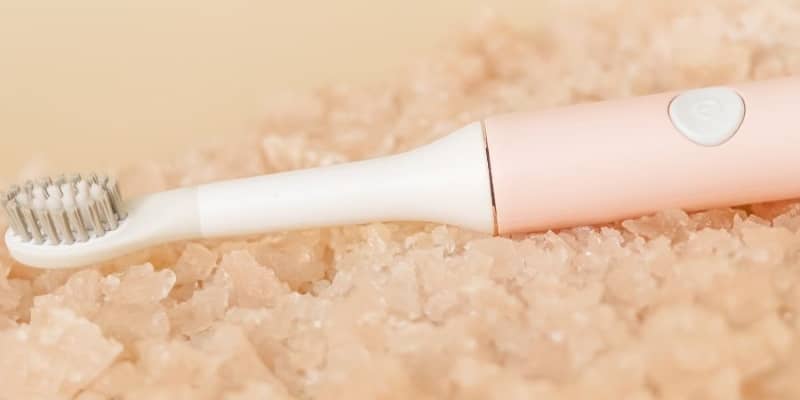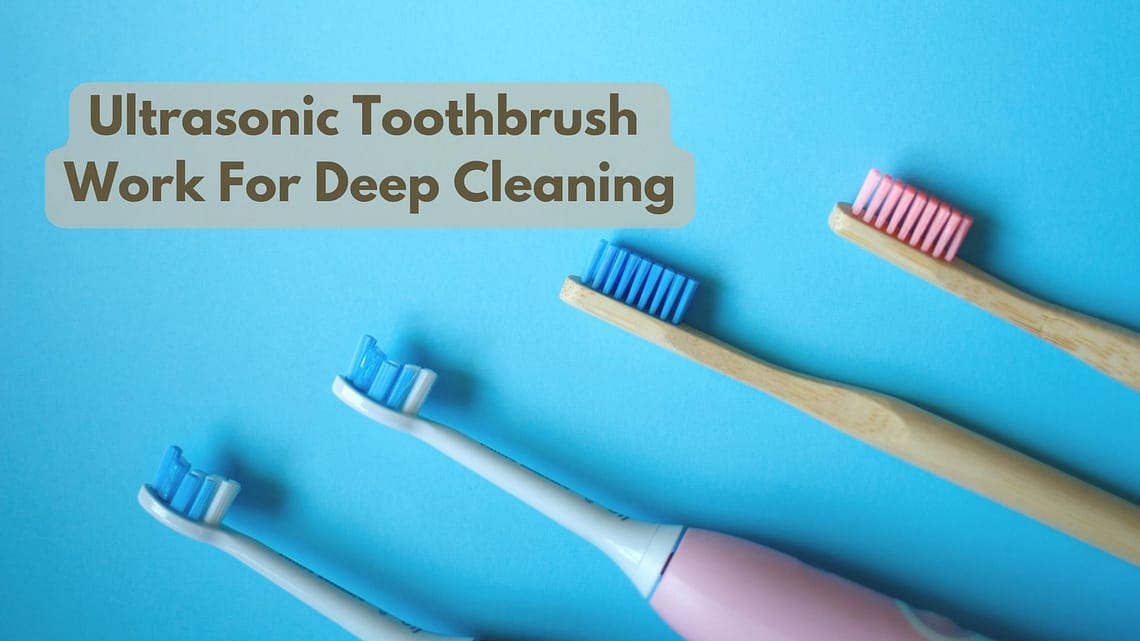Are you looking to achieve a deep and thorough clean for your teeth? If so, then you may be interested in learning about the fascinating technology behind ultrasonic toothbrushes. These toothbrushes utilize high-frequency vibrations to provide a deep cleaning experience that goes beyond what traditional toothbrushes can offer.
In this article, we will explore how ultrasonic toothbrushes work and the benefits they can provide for your oral hygiene routine. Discover the science behind these innovative dental tools and unlock the secret to achieving a truly deep clean for your teeth and gums.
What is an ultrasonic toothbrush?
An ultrasonic toothbrush is a type of dental care device that utilizes ultrasonic technology to clean the teeth and gums. It is an innovative and advanced tool that offers a more effective and efficient way of achieving deep cleaning compared to traditional toothbrushes. In simple terms, an ultrasonic toothbrush uses high-frequency sound waves to generate vibrations that help remove plaque, tartar, and stains, while also providing gum stimulation.
Definition of an ultrasonic toothbrush
An ultrasonic toothbrush is a dental care device that operates at a frequency beyond the range of human hearing, typically between 20,000 and 40,000 vibrations per minute. These high-frequency sound waves produce gentle vibrations, which create microscopic bubbles that effectively clean the teeth and gums. The ultrasonic technology employed in these brushes ensures thorough cleaning and improved oral hygiene.
Innovation of ultrasonic technology
The development of ultrasonic toothbrushes marked a significant advancement in oral care technology. By harnessing the power of ultrasonic waves, these toothbrushes provide a deeper and more efficient level of cleaning compared to conventional toothbrushes. The innovation lies in the ability of ultrasonic technology to produce rapid vibrations that effectively dislodge and remove plaque, tartar, and other oral bacteria. This technology has revolutionized oral hygiene practices and has become a popular choice among individuals seeking superior dental care.
How does an ultrasonic toothbrush differ from a regular toothbrush?
To understand the benefits of an ultrasonic toothbrush, it is important to compare and contrast its mechanism with that of a regular toothbrush.
Mechanism of a regular toothbrush
A regular toothbrush relies on manual brushing techniques to clean the teeth. It primarily relies on the mechanical action of scrubbing to remove plaque and food particles. Although it can be effective to a certain extent, manual brushing may not reach all areas of the mouth and may result in incomplete cleaning. Additionally, the pressure applied during brushing can vary, leading to potential gum irritation or damage.
Benefits of an ultrasonic toothbrush
An ultrasonic toothbrush, on the other hand, offers several benefits over a regular toothbrush. Firstly, the high-frequency vibrations generated by an ultrasonic toothbrush can reach areas that are difficult to access with a manual toothbrush, such as interdental spaces and gum pockets. This ensures a more thorough cleaning and helps prevent the buildup of plaque and tartar. Secondly, the gentle vibrations produced by the ultrasonic toothbrush provide a massaging effect on the gums, promoting blood circulation and gum health. Lastly, the ultrasonic technology eliminates the need for excessive pressure during brushing, reducing the risk of gum sensitivity or damage.
What are the key features of an ultrasonic toothbrush?
An ultrasonic toothbrush incorporates various features that enhance its cleaning effectiveness and overall user experience. Let’s explore some of the key features of an ultrasonic toothbrush:
Sonic vibrations
The primary feature of an ultrasonic toothbrush is its ability to produce sonic vibrations at high frequencies, typically above 20,000 vibrations per minute. These rapid vibrations create a dynamic cleaning action, effectively removing plaque and tartar from the tooth surface and gumline. The sonic vibrations also help disrupt the biofilm formed by bacteria, further improving oral hygiene.
Brush head design
Ultrasonic toothbrushes often come with specially designed brush heads that maximize the cleaning efficiency. These brush heads typically feature bristles of different lengths and densities to effectively clean various areas of the mouth. Some brush heads even have angled bristles to reach difficult-to-access areas, ensuring comprehensive cleaning.
Timer and pacer
To ensure optimal brushing duration, many ultrasonic toothbrushes are equipped with built-in timers. These timers typically run for two minutes, which is the recommended brushing time by dental professionals. In addition to the timer, some toothbrushes also include a pacer that emits a brief pause or signal every 30 seconds, reminding users to switch to a different quadrant of the mouth for even cleaning.
Pressure sensor
To prevent excess pressure and protect the gums from damage, some ultrasonic toothbrushes are equipped with pressure sensors. These sensors detect excessive force applied during brushing and provide feedback, such as a visual or auditory signal, to alert the user to reduce the pressure. This feature ensures gentle and safe brushing, especially for individuals with sensitive gums.
Multiple cleaning modes
Many ultrasonic toothbrushes offer multiple cleaning modes that cater to different dental needs. Common modes include standard cleaning, sensitive mode for gentle cleaning, gum care mode for stimulating and massaging the gums, and deep cleaning mode for intensive plaque removal. Having these options allows users to customize their brushing experience based on their individual requirements.
How does an ultrasonic toothbrush achieve deep cleaning?
The unique combination of sonic vibrations and advanced technology in ultrasonic toothbrushes enables them to achieve deep cleaning in several ways:
Sonic vibrations for plaque removal
The high-frequency sonic vibrations created by an ultrasonic toothbrush effectively dislodge and remove plaque from the teeth. The rapid oscillations generate tiny bubbles in the toothpaste or saliva, which encapsulate plaque and bacteria, breaking them down and sweeping them away. This process ensures a thorough and efficient removal of plaque, reducing the risk of dental issues such as cavities and gum disease.
Microbubbles for interdental cleaning
The ultrasonic waves generated by the toothbrush create small, powerful bubbles known as microbubbles. These bubbles are able to penetrate into the interdental spaces and gum pockets, which are difficult to reach with traditional brushing methods. The microbubbles help dislodge debris, bacteria, and plaque from these areas, ensuring comprehensive interdental cleaning and improved gum health.
Stain and tartar removal
Ultrasonic toothbrushes are highly effective in removing tough stains and tartar buildup. The rapid vibrations and microbubbles generated by the toothbrush help break down and dislodge stubborn stains and tartar deposits, leaving the teeth looking cleaner and brighter. Regular use of an ultrasonic toothbrush can significantly reduce the need for professional cleaning to remove stains and tartar.
Gum stimulation
The gentle vibrations produced by the ultrasonic toothbrush provide a massaging effect on the gums. This stimulation helps improve blood circulation in the gum tissues, promoting gum health and reducing the risk of gum disease. The gentle massage also aids in reducing gum sensitivity and discomfort, making it an ideal choice for individuals with gum-related concerns.

Is an ultrasonic toothbrush suitable for everyone?
While ultrasonic toothbrushes offer numerous benefits, their suitability may vary depending on certain factors. Let’s explore who can benefit from using an ultrasonic toothbrush:
Benefits for people with braces
Individuals with braces can greatly benefit from using an ultrasonic toothbrush. The high-frequency vibrations and microbubbles produced by the toothbrush help dislodge food particles and plaque from around the brackets, wires, and other orthodontic appliances. This ensures thorough cleaning and minimizes the risk of enamel demineralization and tooth decay during the orthodontic treatment.
Considerations for individuals with sensitive teeth or gums
For individuals with sensitive teeth or gums, it is advisable to consult with a dental professional before using an ultrasonic toothbrush. While the gentle vibrations can provide gum stimulation and promote blood circulation, they may cause discomfort for those with highly sensitive gums or exposed tooth roots. Dental professionals can provide personalized advice and recommend suitable brushing techniques or alternative oral care options.
Suitability for children and the elderly
Ultrasonic toothbrushes can be suitable for both children and the elderly. However, special considerations should be taken into account. For children, it is important to choose a toothbrush with age-appropriate features and ensure proper supervision during brushing. The elderly, on the other hand, may have specific oral care needs such as gum recession or denture maintenance, which should be discussed with a dentist to ensure the most suitable toothbrush and oral care routine.
How to effectively use an ultrasonic toothbrush for deep cleaning?
To maximize the benefits of an ultrasonic toothbrush and achieve deep cleaning, it is important to follow these guidelines:
Choosing the right brush head
Select a brush head that is appropriate for your needs and dental condition. There are different brush head designs available, such as compact heads for precise cleaning or softer bristles for sensitive gums. Replace the brush head every three to four months or sooner if the bristles become frayed or worn.
Proper brushing technique
Hold the ultrasonic toothbrush at a slight angle against the gumline and apply light pressure. Avoid scrubbing vigorously, as the high-frequency vibrations will do the cleaning for you. Glide the brush head slowly along the teeth, ensuring that all surfaces, including the front, back, and chewing surfaces, are adequately cleaned.
Optimal brushing duration and frequency
Brush your teeth for at least two minutes, twice a day. Most ultrasonic toothbrushes come with built-in timers to help you achieve the recommended brushing time. It is also important to give equal attention to different areas of the mouth by dividing it into quadrants and spending around 30 seconds on each.
Maintenance and care
After each use, rinse the brush head thoroughly with water and allow it to air dry. Avoid storing the toothbrush in a closed container, as it may promote bacterial growth. In addition, regularly check the toothbrush for signs of wear or damage and replace any worn-out parts promptly. It is also important to keep up with regular dental visits for professional cleanings and check-ups.
Are there any potential drawbacks or precautions related to ultrasonic toothbrushes?
While ultrasonic toothbrushes offer numerous benefits, it is important to be aware of potential drawbacks and take necessary precautions:

Potential discomfort or sensitivity
Some individuals may experience discomfort or sensitivity when using an ultrasonic toothbrush, particularly if they have highly sensitive gums or exposed tooth roots. If you experience any discomfort or persistent sensitivity, it is advisable to consult with a dental professional to determine the cause and find alternative oral care solutions that suit your needs.
Contradictions for certain dental conditions
Individuals with specific dental conditions, such as severe gum disease, gum recession, or dental restorations, should consult with their dentist before using an ultrasonic toothbrush. While the gentle vibrations can be beneficial for most individuals, certain conditions may require special considerations or alternative oral care methods.
Importance of consulting a dentist
Before incorporating an ultrasonic toothbrush into your oral care routine, it is important to consult with a dental professional. They can evaluate your specific dental needs and provide personalized advice on the suitability of an ultrasonic toothbrush, as well as recommend the most appropriate brushing techniques and oral care products.
What are the benefits of using an ultrasonic toothbrush for deep cleaning?
Using an ultrasonic toothbrush for deep cleaning offers several benefits that contribute to overall oral health:
Enhanced plaque removal
The sonic vibrations and microbubbles generated by an ultrasonic toothbrush aid in thorough plaque removal, reaching areas that may be missed by manual brushing alone. This leads to a cleaner and healthier mouth, with reduced risks of tooth decay, gum disease, and other oral health issues.
Improved gum health
The gentle vibrations of an ultrasonic toothbrush provide a massaging effect on the gums, promoting blood circulation and stimulating gum tissue. This can help prevent gum disease, reduce gum inflammation, and improve overall gum health.
Efficient stain and tartar removal
Regular use of an ultrasonic toothbrush can effectively remove stubborn stains and tartar from the teeth. The sonic vibrations and microbubbles work together to break down and dislodge surface stains and tartar deposits, resulting in a brighter and more attractive smile.
Effective interdental cleaning
The microbubbles generated by an ultrasonic toothbrush penetrate into the interdental spaces and gum pockets, ensuring thorough cleaning even in hard-to-reach areas. This helps remove debris, bacteria, and plaque from between the teeth, reducing the risk of cavities and gum disease.
Also Check: What Are The Benefits Of Snail Serum In Skincare Routines?
Can an ultrasonic toothbrush replace regular dental visits?
While an ultrasonic toothbrush is a valuable tool for maintaining oral hygiene, it cannot completely replace regular dental visits. Professional dental cleanings performed by a dentist or dental hygienist are essential for maintaining optimal oral health. These visits allow for comprehensive examinations, deep cleanings, and the detection of any potential dental issues at an early stage. An ultrasonic toothbrush can be used as a complementary tool to enhance daily oral care between dental visits.
The importance of professional dental cleanings
Regular professional dental cleanings are crucial for removing stubborn tartar, detecting early signs of gum disease or dental decay, and addressing any oral health concerns. Dentists and dental hygienists have the expertise and tools necessary to provide thorough cleanings and preventive care that cannot be replicated solely with an ultrasonic toothbrush.
Ultrasonic toothbrush as a complementary tool
An ultrasonic toothbrush can contribute to maintaining optimal oral health alongside regular dental visits. Its deep cleaning capabilities and ability to remove plaque and stains make it an effective tool for home oral care. However, it should be used in conjunction with professional dental cleanings, regular check-ups, and personalized oral hygiene recommendations from a dental professional.
FAQs
How often should I replace the brush head of an ultrasonic toothbrush?
It is recommended to replace the brush head of an ultrasonic toothbrush every three to four months, or sooner if the bristles become frayed or worn. This ensures optimal cleaning performance and prevents the buildup of bacteria on the brush head. Regular replacement of the brush head also helps maintain the effectiveness and hygiene of the toothbrush.
Can children use an ultrasonic toothbrush?
Yes, children can use ultrasonic toothbrushes, but it is important to choose a toothbrush specifically designed for their age group. Many ultrasonic toothbrush brands offer models designed for children, with features such as smaller brush heads, softer bristles, and attractive designs. It is also crucial to supervise children during brushing to ensure they are using the toothbrush correctly and safely.
Does an ultrasonic toothbrush require special toothpaste?
No, an ultrasonic toothbrush does not require special toothpaste. Any toothpaste that is suitable for regular toothbrushes can be used with an ultrasonic toothbrush. However, it is always advisable to consult with a dental professional to determine the most appropriate toothpaste for your specific dental needs. They may recommend toothpaste that addresses specific conditions such as sensitivity, gum disease, or enamel strengthening.





